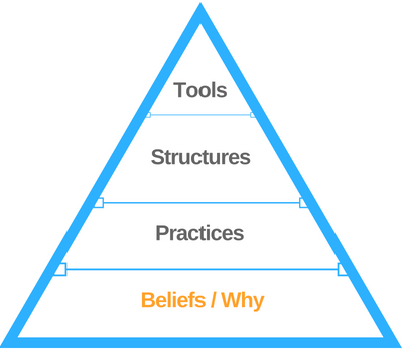TRANSFORMATIONAL LEADERSHIP
VISION and Mission
WHY IS THIS CRITICAL?
A shared vision serves as a signpost for the future and compels others to want a better future for their learners. A shared vision creates common purpose and clear direction for all stakeholders to inspire the learning community to unite toward a future of learning that motivates and supports all to achieve their fullest potential. The mission is “how” to make the vision a reality. A mission provides a clear picture to all stakeholders of the systems and processes that are necessary to achieve the vision. A shared vision and mission is built from a shared belief about why a new vision is necessary and aligned to the values, beliefs and purpose for transformation.
IN WHAT WAYS HAS OUR SCHOOL CONSIDERED UNDERLYING VALUES, BELIEF, AND PURPOSE--THE WHY?

Self-reflection Guide
-
FOUNDATIONAL
HRSC Educational leaders question, evaluate, and assess the school vision and mission with a sense of urgency for transformation of teaching and learning. The vision for the school is grounded on core beliefs, shared values, and the "why” that drive conversations and inspire others to rally around a common purpose and belief toward imagining a future where learning is personalized for each learner.
-
DEVELOPING
A shared vision and mission for learning forms the foundation of all work toward a collective commitment and ownership to common goals and expectations. HRSC Growing involvement and ownership of the vision among stakeholders is evident in the intentional shift from top-down decisions to shared leadership through engagement, collaboration and transparency. The school vision is a living document communicated to guide all stakeholders in a common direction. The mission drives the "how" to make the vision a reality. The mission statement motivates the learning community to change and grow toward a future where all learners have opportunity to access and redefine their fullest potential.
-
SUSTAINING
A dynamic learning community understands and uses a systematic approach to continually analyze and contribute to the vision and mission. Reflective conversations are used to guide deep analysis and consideration of current practices and structures to gauge alignment with the shared vision. The vision communicates equity in meeting the needs of all learners. The mission of the school clearly aligns with the vision and is intentionally communicated regularly and openly using multiple methods to encourage transparency and ongoing feedback. Ownership by the learning community is evident in the use of feedback in subsequent iterations of the vision and mission. HRSC There is a drive for continual learning and a commitment to creating a culture of inquiry for continuous improvement.
What might I consider?
- In what ways has our school considered our underlying values, beliefs and purpose, and the why?
- As you reflect on your vision, what practices, "the HOW" align and support your vision?
- What are some ways you have included parents and community in crafting your vision and mission?
Where might I start?
Engage your team in a self-reflection on the critical attribute: Vision & Mission.
Explore Vision & Mission Transformational LeadershipUsed with permission. From Handbook for High Reliability Schools™: The Next Step in School Reform by Robert J. Marzano, Philip B. Warrick, and Julia A. Simms. Copyright 2014 by Marzano Research, 555 North Morton Street, Bloomington, IN 47404, 800.733.6786, www.marzanoresearch.com
